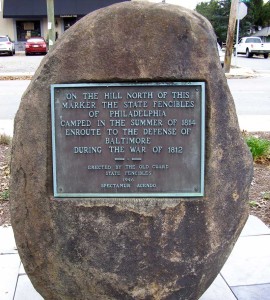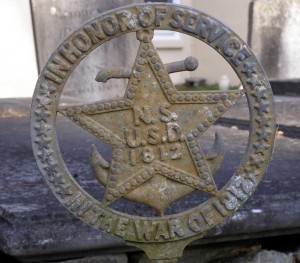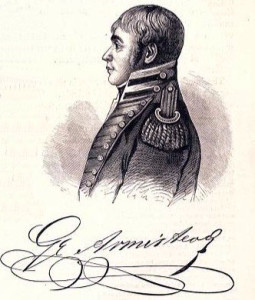Chester County played large role in now almost forgotten War of 1812
By Gene Pisasale, Special to The Times

A marker in Kennett Square commemorates the American troops that encamped near the current location of the Country Butcher at Cypress and Walnut streets.
America was woefully unprepared to wage a second war against Great Britain. As England purchased 80% of our cotton and 50% of all other exports, many businessmen were strongly opposed to the move. The U.S. Army was in its infancy, relying largely on state and local militias. Our Navy was not much better- facing a foe whose fleet was 65 times its size. Madison often quoted Benjamin Franklin, saying: “The War of Revolution is won, but the War for Independence is yet to be fought.” The country would soon be immersed in an overwhelming maelstrom, combat raging from the Great Lakes to New Orleans and the open seas. Chester County was removed from much of the action. Although no battles were fought near Philadelphia, local patriots were ready to fight if the conflict came.
Futhey and Cope’s ‘History of Chester County, Pennsylvania’ lists correspondence with Pennsylvania Governor Simon Snyder from citizens who participated in the conflict. One of these letters was from James Ralston, a Captain in the Cavalry from Chester County.
“Although we deprecate war, with all its train of concomitant evils, yet we, as a troop or band of brothers, are ready to stand forth in the defense of our country’s rights…”

A marker in a graveyyard near the intersection of Route 10 and Route 340, commemorates the veterans of The War of 1812.
at the intersection of Route 10 and Route 340, an aging graveyard commemorates the heroes of this war, bronze sculptures standing tall near their graves.
After the British burned the White House and much of Washington, D.C., Governor Snyder issued a proclamation for militia to muster in “…the counties of Philadelphia, Bucks, Montgomery, Delaware, Chester, Lancaster…” Five thousand of the troops were scheduled to rendezvous at York, Pa. A temporary settlement named after a Revolutionary War General called ‘Camp Bloomfield’ was built for them near Kennett Square. The Advance Light Brigade formed there under the command of General Thomas Cadwalader, later ordered by Bloomfield to reassemble at Marcus Hook.
Several local officers served, including Major Generals Cromwell Pearce, James Steel and Brigadier Generals William Harris and John W. Cunningham. These men would march to protect the city of Baltimore, whose stronghold- Fort McHenry- would be attacked by the British in September 1814. The Fort’s commander- Lt. Colonel George Armistead- had ordered 320,000 rounds of ammunition to defend the bastion. Much of the gunpowder came from an upstart company named Du Pont based along the Brandywine near Wilmington, Delaware. The attack on Fort McHenry inspired a young lawyer named Francis Scott Key to write a poem that aroused a nation and became our National Anthem.
Shoppers at The Country Butcher on Walnut Street in Kennett Square may not notice the large boulder which sits nearby on an island amidst roaring traffic. The stone holds a plaque that reads “On the hill north of this marker the State Fencibles of Philadelphia camped in the Summer of 1814 en route to the defense of Baltimore during the War of 1812.” In the cemetery of Old St. John’s Church in Compass, Pa. two weathered bronze markers erected by the National Society of the U.S. Daughters of the War of 1812 stand alongside gravestones whose epitaphs disappeared long ago. Their proclamation is modest: “In Honor of Service in the War of 1812”. A star sits prominently in the center of each one, still visible despite two centuries of rain, sleet and snow.

An etching of Lt. Colonel George Armistead, the commander at Fort McHenry. His daughter later became a resident of West Chester, and helped historians learn more about her father and the famous battle that inspired The Star-Spangled Banner.
Mary Armistead- daughter of the commander at Fort McHenry- married John Bradford and lived in West Chester, Pa. While writing his revealing study of the war ‘The Pictorial Field-Book of the War of 1812’, author Benson J. Lossing met with Mrs. Armistead. She presented him with an etching of her famous father, which made it into the book along with hundreds of other detailed illustrations. Thus, a descendant of the man who defended the Star-Spangled Banner helped later generations to know its story.
If you’re shopping at The Country Butcher, before you drive away, walk over to the plaque, flowers sitting alongside to honor these men.
To the northwest at the intersection of Route 10 and Route 340, an aging graveyard commemorates the heroes of this war, bronze sculptures standing tall near their graves. The best way to appreciate our Veterans is to never forget them and the importance of what they did long ago… for the blessings of liberty we enjoy today.
Gene Pisasale is an author based in Kennett Square whose books and lecture series focus on historical topics. His latest work is “The Forgotten Star”, an historical novel of the War of 1812 and true-life mysteries surrounding an American icon- the Star-Spangled Banner. Gene will be presenting his new lecture “The War of 1812- The Conflict That Forged A Nation” at the Bayard Taylor Library, 216 East State Street in downtown Kennett Square on Saturday March 23rd at 2 p.m. The event is free and open to the public. For more information, call the Library at 610-444-2702. His website is www.GenePisasale.com; Gene can be reached at Ge**@**********le.com.




